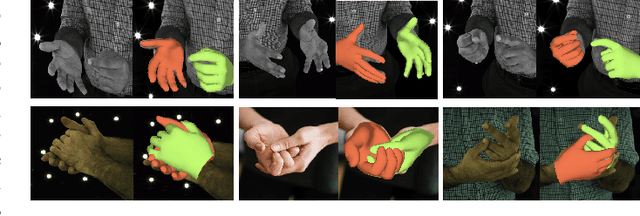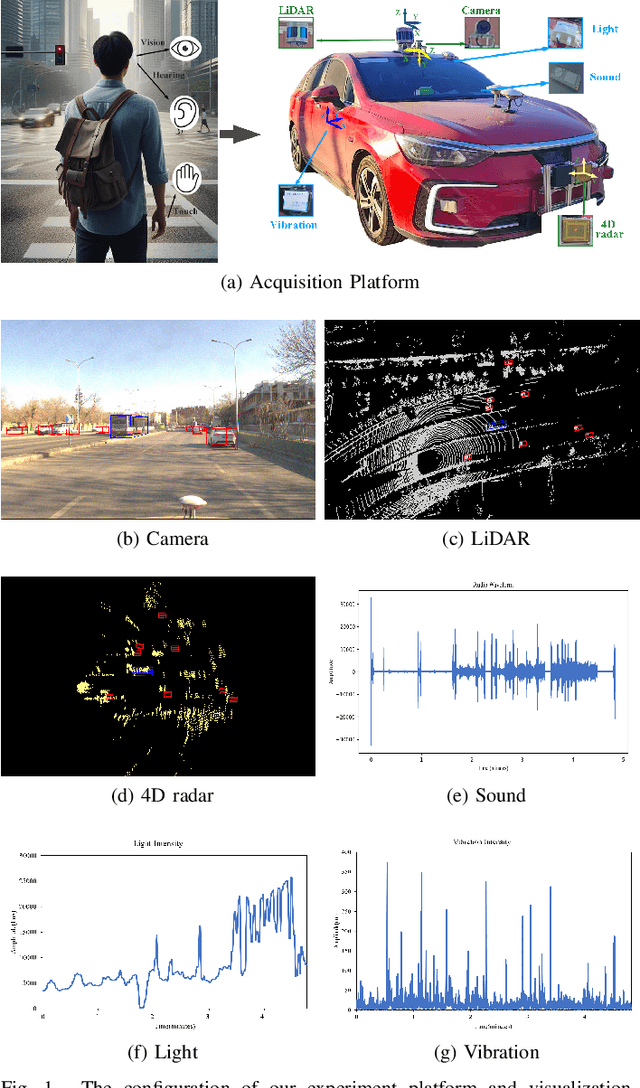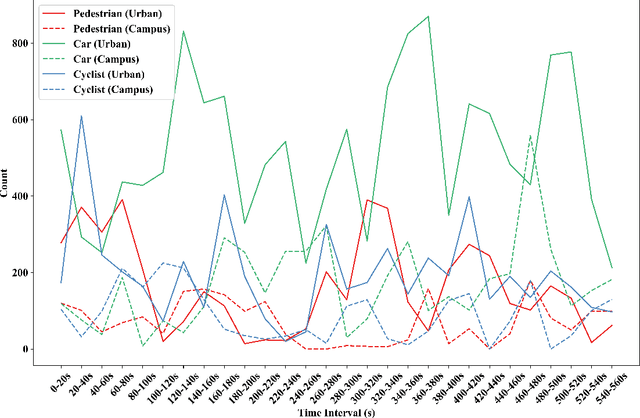Wenzhuo Liu
C-NAV: Towards Self-Evolving Continual Object Navigation in Open World
Oct 23, 2025Abstract:Embodied agents are expected to perform object navigation in dynamic, open-world environments. However, existing approaches typically rely on static trajectories and a fixed set of object categories during training, overlooking the real-world requirement for continual adaptation to evolving scenarios. To facilitate related studies, we introduce the continual object navigation benchmark, which requires agents to acquire navigation skills for new object categories while avoiding catastrophic forgetting of previously learned knowledge. To tackle this challenge, we propose C-Nav, a continual visual navigation framework that integrates two key innovations: (1) A dual-path anti-forgetting mechanism, which comprises feature distillation that aligns multi-modal inputs into a consistent representation space to ensure representation consistency, and feature replay that retains temporal features within the action decoder to ensure policy consistency. (2) An adaptive sampling strategy that selects diverse and informative experiences, thereby reducing redundancy and minimizing memory overhead. Extensive experiments across multiple model architectures demonstrate that C-Nav consistently outperforms existing approaches, achieving superior performance even compared to baselines with full trajectory retention, while significantly lowering memory requirements. The code will be publicly available at https://bigtree765.github.io/C-Nav-project.
SAIL-VL2 Technical Report
Sep 18, 2025Abstract:We introduce SAIL-VL2, an open-suite vision-language foundation model (LVM) for comprehensive multimodal understanding and reasoning. As the successor to SAIL-VL, SAIL-VL2 achieves state-of-the-art performance at the 2B and 8B parameter scales across diverse image and video benchmarks, demonstrating strong capabilities from fine-grained perception to complex reasoning. Its effectiveness is driven by three core innovations. First, a large-scale data curation pipeline with scoring and filtering strategies enhances both quality and distribution across captioning, OCR, QA, and video data, improving training efficiency. Second, a progressive training framework begins with a powerful pre-trained vision encoder (SAIL-ViT), advances through multimodal pre-training, and culminates in a thinking-fusion SFT-RL hybrid paradigm that systematically strengthens model capabilities. Third, architectural advances extend beyond dense LLMs to efficient sparse Mixture-of-Experts (MoE) designs. With these contributions, SAIL-VL2 demonstrates competitive performance across 106 datasets and achieves state-of-the-art results on challenging reasoning benchmarks such as MMMU and MathVista. Furthermore, on the OpenCompass leaderboard, SAIL-VL2-2B ranks first among officially released open-source models under the 4B parameter scale, while serving as an efficient and extensible foundation for the open-source multimodal community.
The Effects of Communication Delay on Human Performance and Neurocognitive Responses in Mobile Robot Teleoperation
Aug 25, 2025Abstract:Communication delays in mobile robot teleoperation adversely affect human-machine collaboration. Understanding delay effects on human operational performance and neurocognition is essential for resolving this issue. However, no previous research has explored this. To fill this gap, we conduct a human-in-the-loop experiment involving 10 participants, integrating electroencephalography (EEG) and robot behavior data under varying delays (0-500 ms in 100 ms increments) to systematically investigate these effects. Behavior analysis reveals significant performance degradation at 200-300 ms delays, affecting both task efficiency and accuracy. EEG analysis discovers features with significant delay dependence: frontal $\theta/\beta$-band and parietal $\alpha$-band power. We also identify a threshold window (100-200 ms) for early perception of delay in humans, during which these EEG features first exhibit significant differences. When delay exceeds 400 ms, all features plateau, indicating saturation of cognitive resource allocation at physiological limits. These findings provide the first evidence of perceptual and cognitive delay thresholds during teleoperation tasks in humans, offering critical neurocognitive insights for the design of delay compensation strategies.
MCITlib: Multimodal Continual Instruction Tuning Library and Benchmark
Aug 10, 2025Abstract:Continual learning aims to equip AI systems with the ability to continuously acquire and adapt to new knowledge without forgetting previously learned information, similar to human learning. While traditional continual learning methods focusing on unimodal tasks have achieved notable success, the emergence of Multimodal Large Language Models has brought increasing attention to Multimodal Continual Learning tasks involving multiple modalities, such as vision and language. In this setting, models are expected to not only mitigate catastrophic forgetting but also handle the challenges posed by cross-modal interactions and coordination. To facilitate research in this direction, we introduce MCITlib, a comprehensive and constantly evolving code library for continual instruction tuning of Multimodal Large Language Models. In MCITlib, we have currently implemented 8 representative algorithms for Multimodal Continual Instruction Tuning and systematically evaluated them on 2 carefully selected benchmarks. MCITlib will be continuously updated to reflect advances in the Multimodal Continual Learning field. The codebase is released at https://github.com/Ghy0501/MCITlib.
A Comprehensive Survey on Continual Learning in Generative Models
Jun 16, 2025Abstract:The rapid advancement of generative models has enabled modern AI systems to comprehend and produce highly sophisticated content, even achieving human-level performance in specific domains. However, these models remain fundamentally constrained by catastrophic forgetting - a persistent challenge where adapting to new tasks typically leads to significant degradation in performance on previously learned tasks. To address this practical limitation, numerous approaches have been proposed to enhance the adaptability and scalability of generative models in real-world applications. In this work, we present a comprehensive survey of continual learning methods for mainstream generative models, including large language models, multimodal large language models, vision language action models, and diffusion models. Drawing inspiration from the memory mechanisms of the human brain, we systematically categorize these approaches into three paradigms: architecture-based, regularization-based, and replay-based methods, while elucidating their underlying methodologies and motivations. We further analyze continual learning setups for different generative models, including training objectives, benchmarks, and core backbones, offering deeper insights into the field. The project page of this paper is available at https://github.com/Ghy0501/Awesome-Continual-Learning-in-Generative-Models.
LLaVA-c: Continual Improved Visual Instruction Tuning
Jun 10, 2025Abstract:Multimodal models like LLaVA-1.5 achieve state-of-the-art visual understanding through visual instruction tuning on multitask datasets, enabling strong instruction-following and multimodal performance. However, multitask learning faces challenges such as task balancing, requiring careful adjustment of data proportions, and expansion costs, where new tasks risk catastrophic forgetting and need costly retraining. Continual learning provides a promising alternative to acquiring new knowledge incrementally while preserving existing capabilities. However, current methods prioritize task-specific performance, neglecting base model degradation from overfitting to specific instructions, which undermines general capabilities. In this work, we propose a simple but effective method with two modifications on LLaVA-1.5: spectral-aware consolidation for improved task balance and unsupervised inquiry regularization to prevent base model degradation. We evaluate both general and task-specific performance across continual pretraining and fine-tuning. Experiments demonstrate that LLaVA-c consistently enhances standard benchmark performance and preserves general capabilities. For the first time, we show that task-by-task continual learning can achieve results that match or surpass multitask joint learning. The code will be publicly released.
VM-BHINet:Vision Mamba Bimanual Hand Interaction Network for 3D Interacting Hand Mesh Recovery From a Single RGB Image
Apr 20, 2025



Abstract:Understanding bimanual hand interactions is essential for realistic 3D pose and shape reconstruction. However, existing methods struggle with occlusions, ambiguous appearances, and computational inefficiencies. To address these challenges, we propose Vision Mamba Bimanual Hand Interaction Network (VM-BHINet), introducing state space models (SSMs) into hand reconstruction to enhance interaction modeling while improving computational efficiency. The core component, Vision Mamba Interaction Feature Extraction Block (VM-IFEBlock), combines SSMs with local and global feature operations, enabling deep understanding of hand interactions. Experiments on the InterHand2.6M dataset show that VM-BHINet reduces Mean per-joint position error (MPJPE) and Mean per-vertex position error (MPVPE) by 2-3%, significantly surpassing state-of-the-art methods.
MMTL-UniAD: A Unified Framework for Multimodal and Multi-Task Learning in Assistive Driving Perception
Apr 03, 2025Abstract:Advanced driver assistance systems require a comprehensive understanding of the driver's mental/physical state and traffic context but existing works often neglect the potential benefits of joint learning between these tasks. This paper proposes MMTL-UniAD, a unified multi-modal multi-task learning framework that simultaneously recognizes driver behavior (e.g., looking around, talking), driver emotion (e.g., anxiety, happiness), vehicle behavior (e.g., parking, turning), and traffic context (e.g., traffic jam, traffic smooth). A key challenge is avoiding negative transfer between tasks, which can impair learning performance. To address this, we introduce two key components into the framework: one is the multi-axis region attention network to extract global context-sensitive features, and the other is the dual-branch multimodal embedding to learn multimodal embeddings from both task-shared and task-specific features. The former uses a multi-attention mechanism to extract task-relevant features, mitigating negative transfer caused by task-unrelated features. The latter employs a dual-branch structure to adaptively adjust task-shared and task-specific parameters, enhancing cross-task knowledge transfer while reducing task conflicts. We assess MMTL-UniAD on the AIDE dataset, using a series of ablation studies, and show that it outperforms state-of-the-art methods across all four tasks. The code is available on https://github.com/Wenzhuo-Liu/MMTL-UniAD.
Federated Continual Instruction Tuning
Mar 17, 2025Abstract:A vast amount of instruction tuning data is crucial for the impressive performance of Large Multimodal Models (LMMs), but the associated computational costs and data collection demands during supervised fine-tuning make it impractical for most researchers. Federated learning (FL) has the potential to leverage all distributed data and training resources to reduce the overhead of joint training. However, most existing methods assume a fixed number of tasks, while in real-world scenarios, clients continuously encounter new knowledge and often struggle to retain old tasks due to memory constraints. In this work, we introduce the Federated Continual Instruction Tuning (FCIT) benchmark to model this real-world challenge. Our benchmark includes two realistic scenarios, encompassing four different settings and twelve carefully curated instruction tuning datasets. To address the challenges posed by FCIT, we propose dynamic knowledge organization to effectively integrate updates from different tasks during training and subspace selective activation to allocate task-specific output during inference. Extensive experimental results demonstrate that our proposed method significantly enhances model performance across varying levels of data heterogeneity and catastrophic forgetting. Our source code and dataset will be made publicly available.
MIPD: A Multi-sensory Interactive Perception Dataset for Embodied Intelligent Driving
Nov 08, 2024



Abstract:During the process of driving, humans usually rely on multiple senses to gather information and make decisions. Analogously, in order to achieve embodied intelligence in autonomous driving, it is essential to integrate multidimensional sensory information in order to facilitate interaction with the environment. However, the current multi-modal fusion sensing schemes often neglect these additional sensory inputs, hindering the realization of fully autonomous driving. This paper considers multi-sensory information and proposes a multi-modal interactive perception dataset named MIPD, enabling expanding the current autonomous driving algorithm framework, for supporting the research on embodied intelligent driving. In addition to the conventional camera, lidar, and 4D radar data, our dataset incorporates multiple sensor inputs including sound, light intensity, vibration intensity and vehicle speed to enrich the dataset comprehensiveness. Comprising 126 consecutive sequences, many exceeding twenty seconds, MIPD features over 8,500 meticulously synchronized and annotated frames. Moreover, it encompasses many challenging scenarios, covering various road and lighting conditions. The dataset has undergone thorough experimental validation, producing valuable insights for the exploration of next-generation autonomous driving frameworks.
 Add to Chrome
Add to Chrome Add to Firefox
Add to Firefox Add to Edge
Add to Edge